Environment
Managing Chemical Substances
Preventing Pollution and Managing Chemical Substances
We are working for the prevention of air and water pollution, the appropriate management of toxic chemical substances, and the reduction of related emissions.
Preventing Air Pollution
Our production activities comply with the standards stipulated in the Air Pollution Control Act as well as the criteria in agreements with local governments.
Regarding the atmosphere, SOx, NOx, and soot and dust emissions from all parent manufacturing sites decreased in fiscal 2023 from the previous fiscal year. This was mainly due to the effect of reducing coal used in the boilers.
Note: Amounts reported here may not fully match, due to rounding.
SOx Emissions
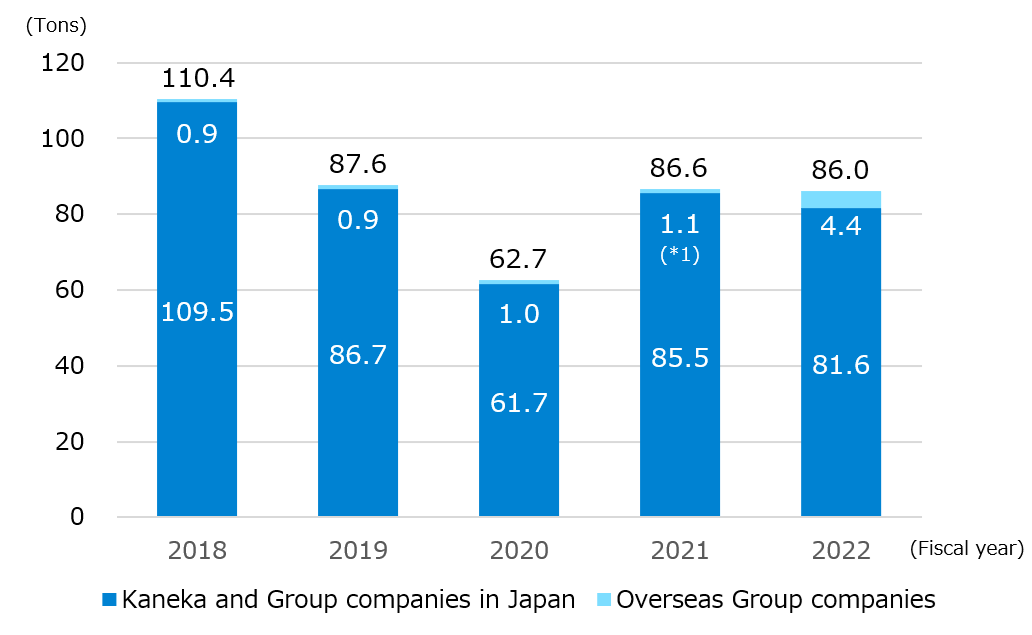
NOx Emissions
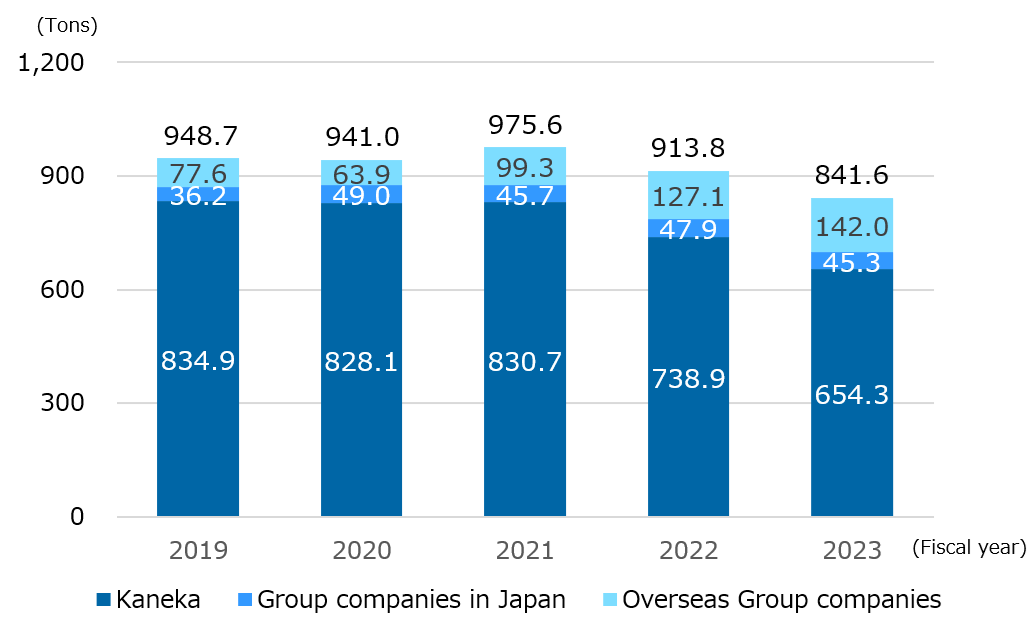
Soot and Dust Emissions
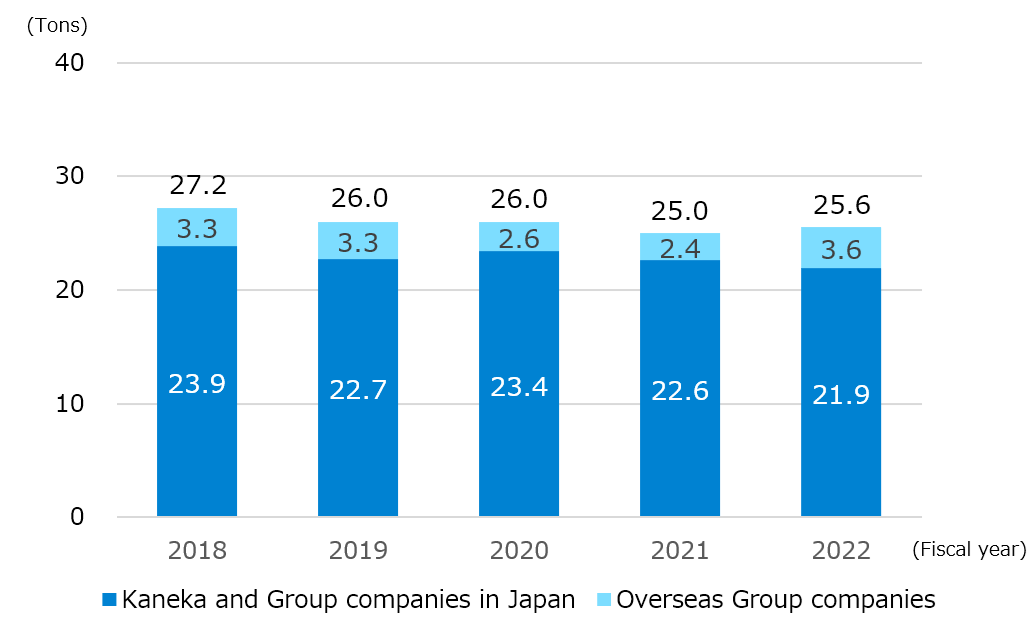
Water Conservation
Our production activities comply with the standards stipulated in the Water Pollution Control Act as well as the criteria in agreements with local governments.
In fiscal 2023, Kaneka Group consumed 33.0 million m3 of water and discharged 29.8 million m3 of water. We monitor the amount of water intake and strive to use water efficiently. To prevent water pollution, we aim to maintain and improve the quality of wastewater discharged into public water bodies.
To promote water conservation, we monitor our intake of water and take care to use it efficiently. To conduct water risk assessments for each Kaneka Group site and the bases of Group companies in Japan and overseas, we used an assessment tool (Aqueduct Water Risk Atlas) to identify areas with high water stress and, based on the proportion of water intake from water-stressed areas to total water intake, and confirmed that Kaneka Group as a whole does not face high water risks. Going forward, we will expand the scope of the assessment targets in terms of geographical location and time, and prioritize and implement measures based on results of the assessment.
Note: Amounts reported here may not fully match, due to rounding.
Water Consumption (*1)
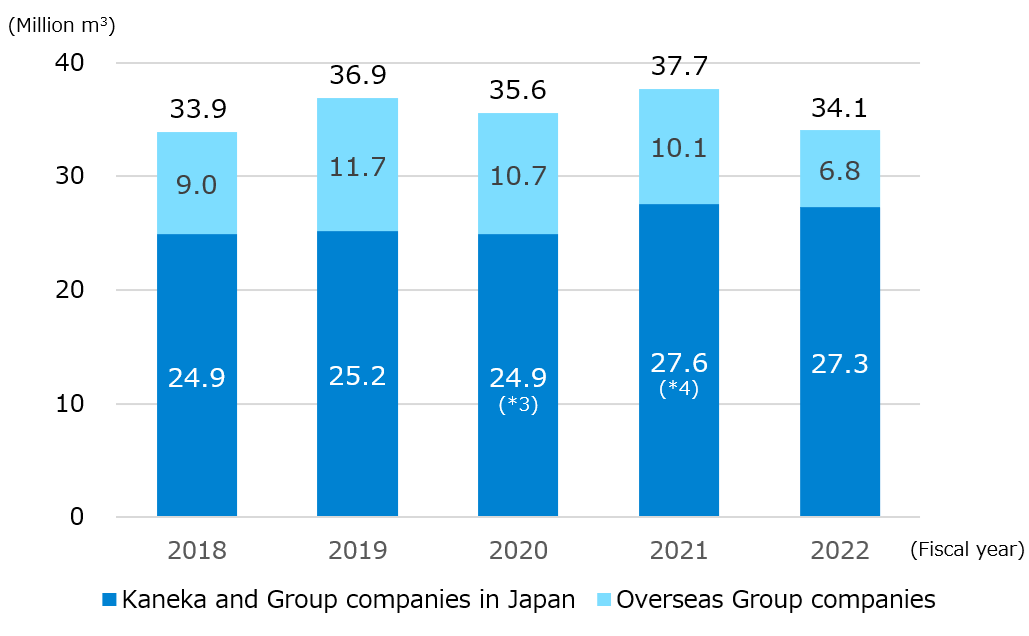
Wastewater Discharges (*1)
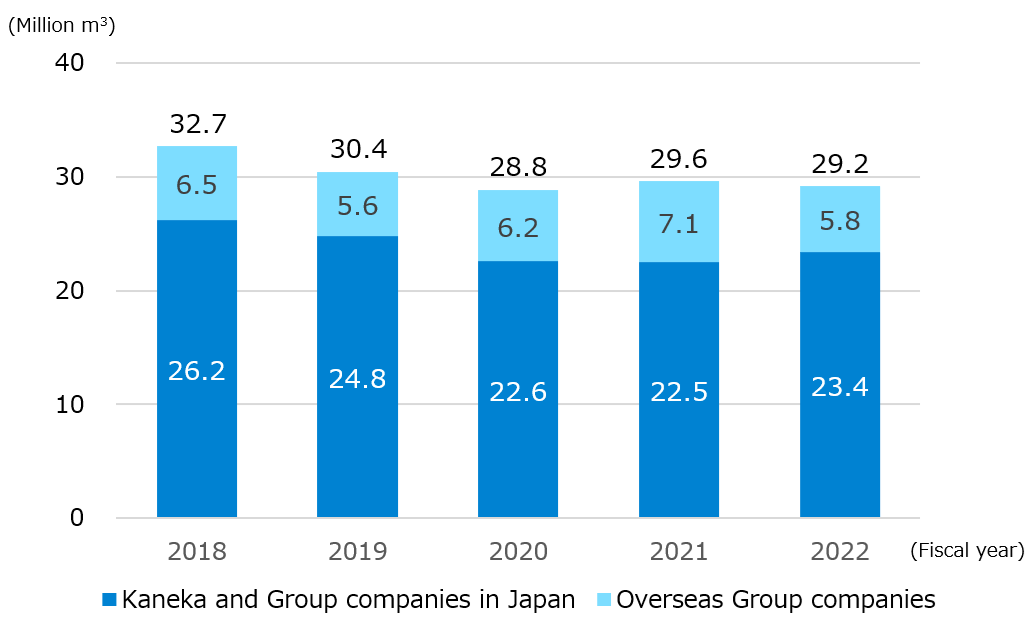
Chemical Oxygen Demand in Wastewater (*1) (*2)
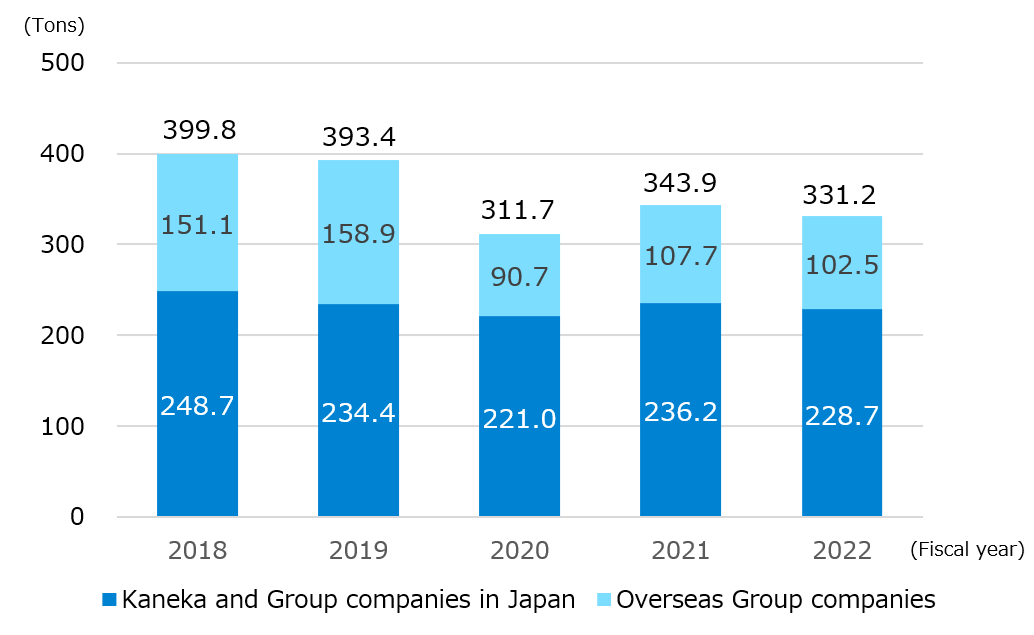
Nitrogen in Wastewater (*1) (*2)
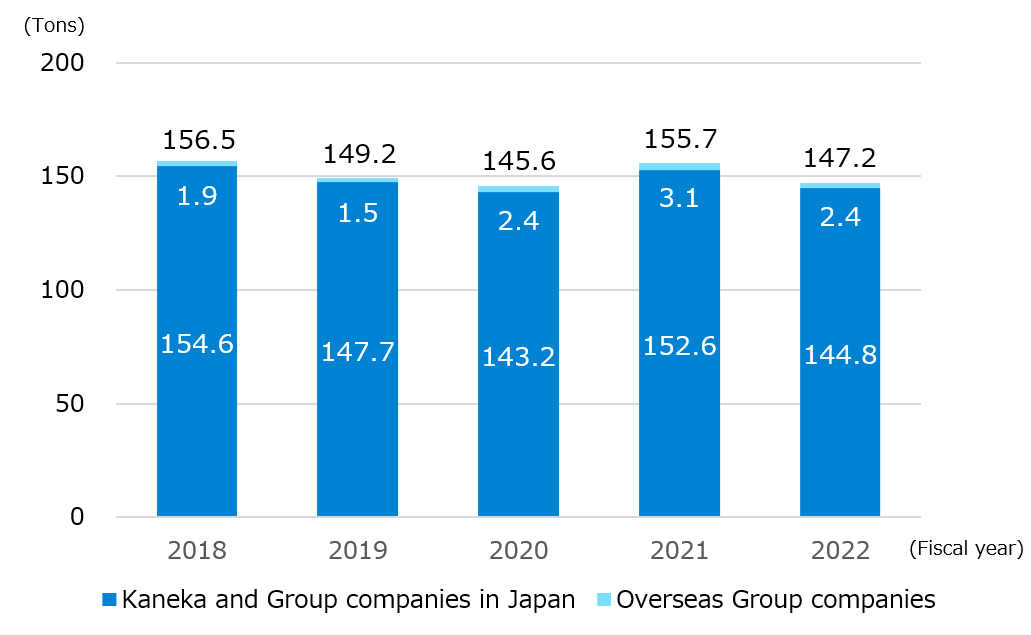
Phosphorus in Wastewater (*1) (*2)
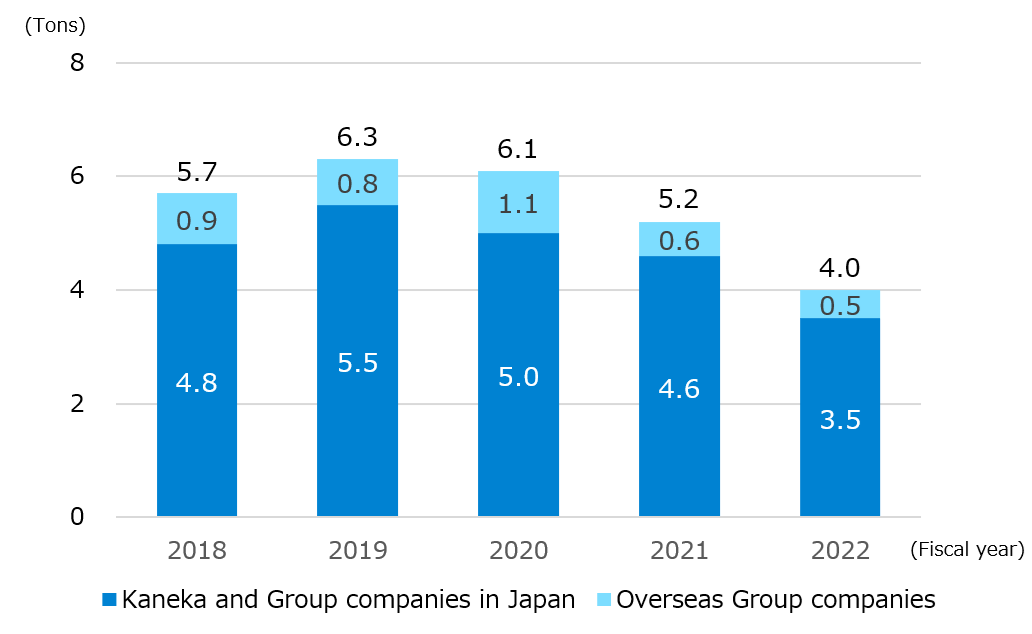
Suspended Solids in Wastewater (*1) (*2)
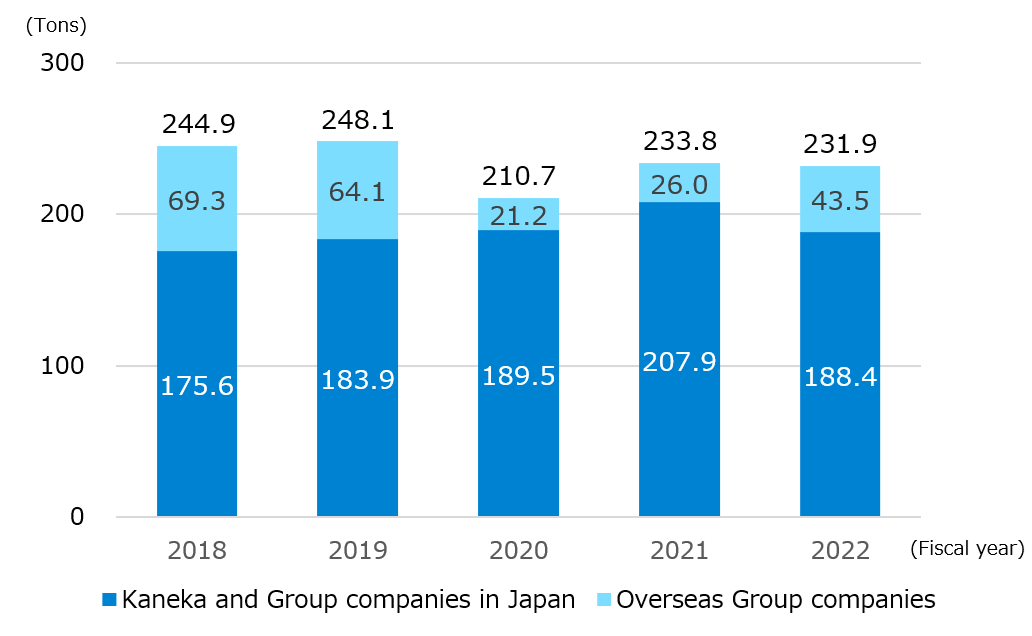
*1 Our water consumptions and wastewater volume include those generated from non-manufacturing facilities other than the plant department.
*2 Starting from the fiscal 2023 results, overseas Group companies are subject to third-party assurance. A review of data for and prior to fiscal 2022 revealed input errors, etc. The actual values have therefore been revised.
Volatile Organic Compounds Emission Reductions
We are committed to reducing the emission of VOCs (*3), which are known to cause photochemical smog. In fiscal 2015, we at Kaneka set the goal of controlling VOC emissions to below 1,800 tons.
In fiscal 2023, VOC emissions totaled 1,687 tons, a reduction of 7.3% from the previous fiscal year, achieving our target. To reduce VOC emissions, we are focusing on improving the recovery rate of acetone, which accounts for 45% of VOC emissions, by increasing refrigeration capacity through refrigeration equipment upgrades. We will continue our efforts to manage and reduce VOC emissions.
*3 Volatile Organic Compounds (VOCs) are organic chemical substances that cause suspended particulate matter and photochemical oxidants.
VOC Emissions (Kaneka)
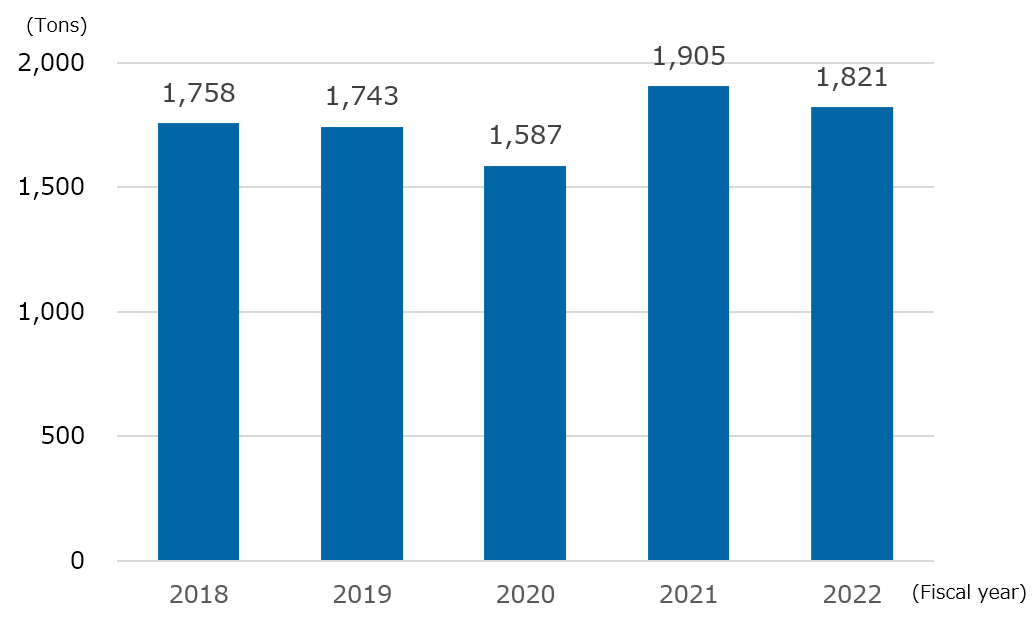
Hazardous Atmospheric Pollutants
Kaneka is voluntarily aiming to reduce emissions of hazardous atmospheric pollutants (shown by manufacturing site in the following graphs). Total emissions of these six pollutants in fiscal 2023 were 18.6 tons, representing a 22.8% decrease from the previous year’s 24.1 tons.
The decrease in emissions was due to two main factors: a temporary increase in 1,2-dichloroethane emissions due to equipment malfunctions in the previous year, which was resolved through equipment improvements; and a reduction in dichloromethane handling volume due to decreased production. At the Takasago Manufacturing Site, we are strengthening facility management to curb emissions of these hazardous air pollutants. We will continue our efforts to control emissions and reduce environmental impact.
Chloroethylene Emissions
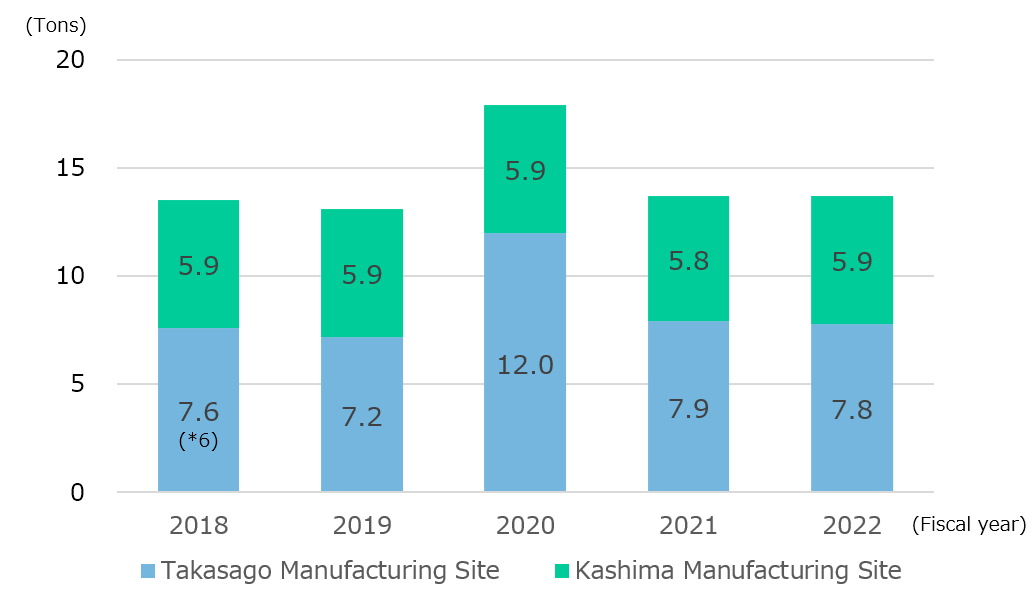
1,2-Dichloroethane Emissions
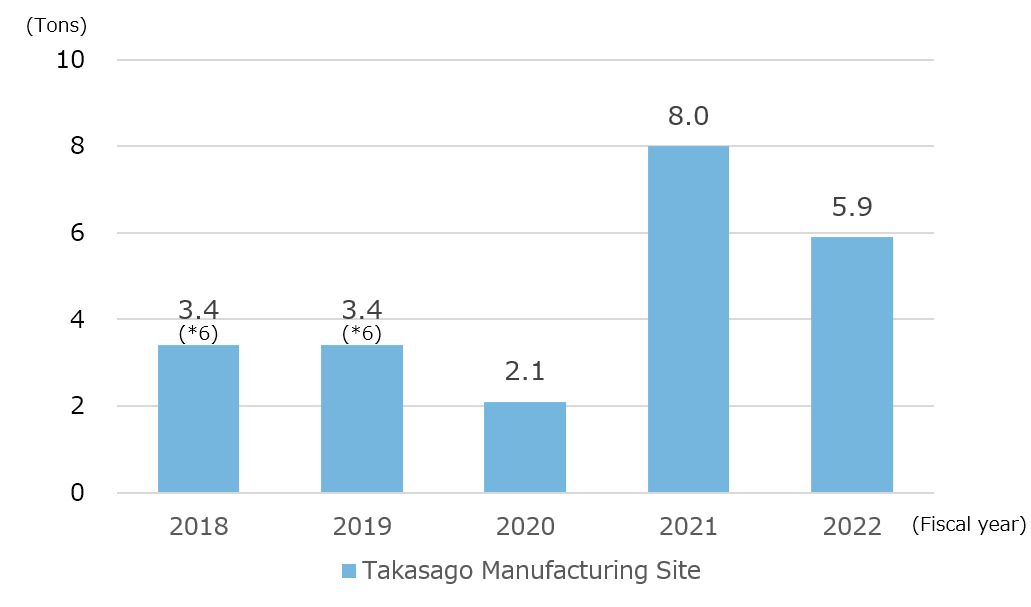
Chloroform Emissions
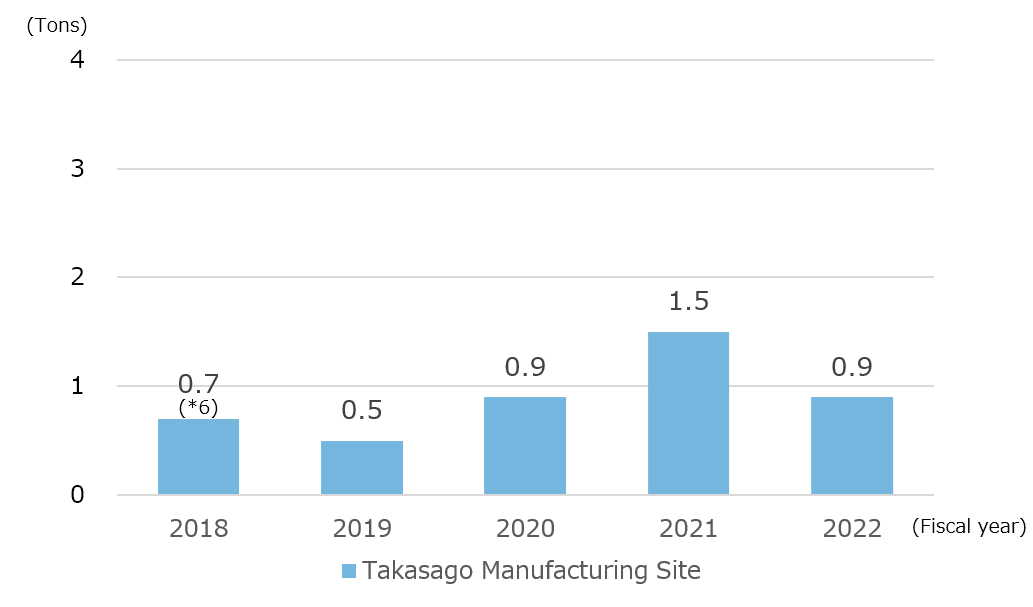
Acrylonitrile Emissions
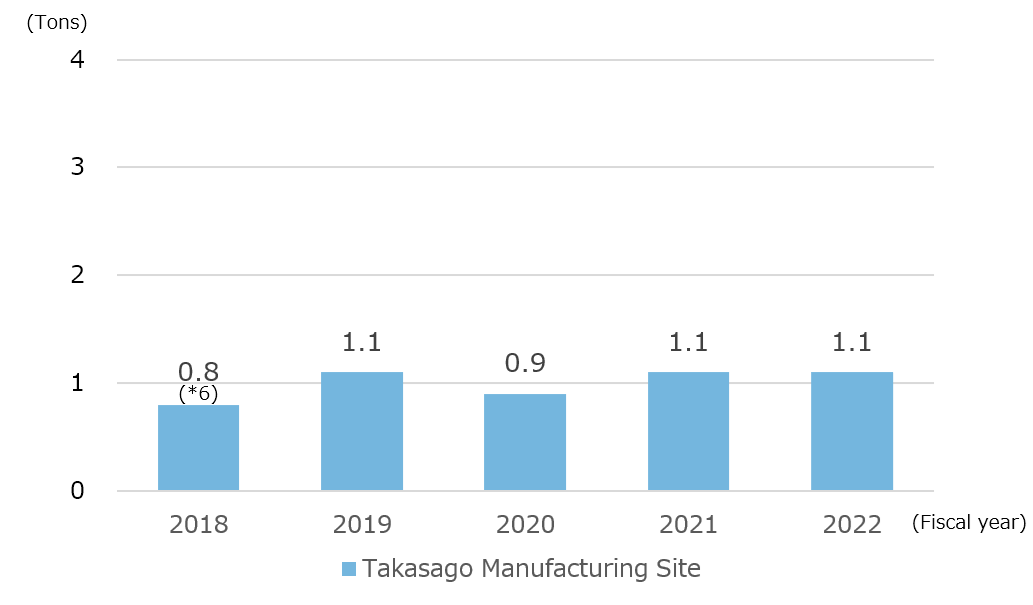
1,3-Butadiene Emissions
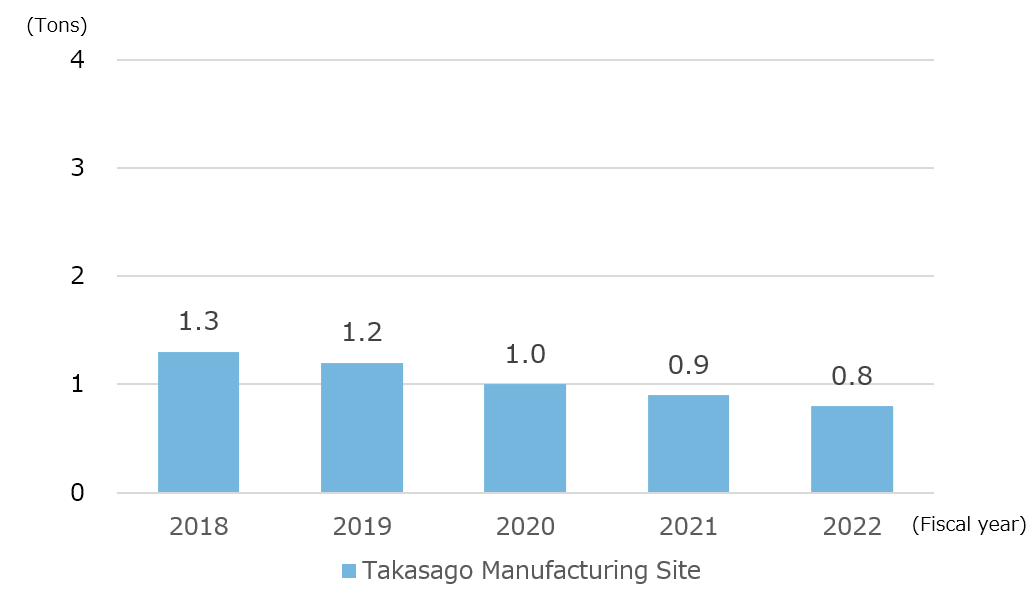
Dichloromethane Emissions
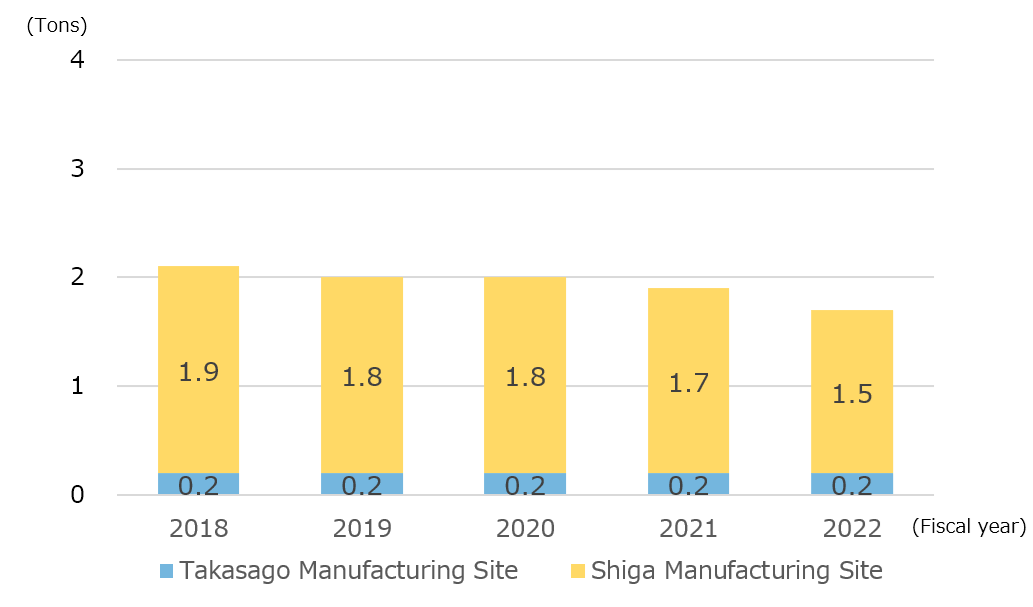
Substances Subject to the PRTR Law
Based on the Act on the Assessment of Releases of Specified Chemical Substances in the Environment and the Promotion of Management Improvement (PRTR Law), we calculate the release and transfer amount of chemical substances subject to the law.
Due to amendments in the PRTR Law, the list of substances subject to reporting has changed. As a result, 13 substances at Kaneka and five substances at our Group companies in Japan are now newly subject to reporting. Among these, the substances that significantly impacted the increase in emissions were tetrahydrofuran, ethylenediaminetetraacetic acid and sodium salts, salt of alkyl (benzyl) (dimethyl) ammonium, and cyclohexane.
Kaneka Emissions Subject to the PRTR Law
(Kilograms)
| JPSN (Japan PRTR-SDS Number) | Chemical Substances | Fiscal 2023 | Fiscal 2022 | ||||||
|---|---|---|---|---|---|---|---|---|---|
| Emissions | Transferred | Emissions | |||||||
| Atmospheric Emissions | Discharges into Public Waterways | Discharges into Soil | Internal Landfill | Total | Total | Total | |||
| Large Discharges of 10 Substances | 392 | Hexane | 20,699 | 0 | 0 | 0 | 20,699 | 108,062 | 24,336 |
| 595 | Ethylenediaminetetraacetic acid and its potassium and sodium salts | 0 | 19,521 | 0 | 0 | 19,521 | 1,136 | - | |
| 134 | Vinyl acetate | 13,949 | 308 | 0 | 0 | 14,257 | 0 | 6,486 | |
| 94 | Chloroethylene (synonym: Vinyl chloride) | 12,974 | 659 | 0 | 0 | 13,632 | 954 | 14,192 | |
| 275 | Sodium dodecyl sulfate | 0 | 8,504 | 0 | 0 | 8,504 | 0 | 8,479 | |
| 420 | Methyl methacrylate | 4,983 | 41 | 0 | 0 | 5,024 | 2 | 5,258 | |
| 674 | Tetrahydrofuran | 3,650 | 0 | 0 | 0 | 3,650 | 6,181 | - | |
| 232 | N,N-Dimethylformamide | 2,276 | 1,142 | 0 | 0 | 3,418 | 216,231 | 3,185 | |
| 7 | Butyl acrylate | 3,312 | 1 | 0 | 0 | 3,313 | 2,881 | 3,306 | |
| 123 | 3-Chloropropene (synonym: Allyl chloride) | 3,252 | 0 | 0 | 0 | 3,252 | 0 | 2,827 | |
| Total Other than the 10 Substances Above | 14,090 | 5,254 | 0 | 0 | 19,344 | 154,789 | 24,979 | ||
| Grand Total for All Substances | 79,184 | 35,429 | 0 | 0 | 114,613 | 490,235 | 93,048 | ||
Note:
Of the 515 substances subject to the PRTR Law, Kaneka reports about 61 items.
Amounts reported here may not fully match, due to rounding.
Group Companies in Japan Emissions Subject to the PRTR Law
(Kilograms)
| JPSN(Japan PRTR-SDS Number) | Chemical Substances | Fiscal 2023 | Fiscal 2022 | ||||||
|---|---|---|---|---|---|---|---|---|---|
| Emissions | Transferred | Emissions | |||||||
| Atmospheric Emissions | Discharges into Public Waterways | Discharges into Soil | Internal Landfill | Total | Total | Total | |||
| Large Discharges of 10 Substances | 232 | N,N-Dimethylformamide | 35,040 | 0 | 0 | 0 | 35,040 | 17,659 | 41,111 |
| 300 | Toluene | 26,924 | 0 | 0 | 0 | 26,924 | 745,322 | 19,763 | |
| 691 | Trimethylbenzene | 2,805 | 0 | 0 | 0 | 2,805 | 0 | 2,696 | |
| 80 | Xylene | 2,619 | 0 | 0 | 0 | 2,619 | 0 | 2,517 | |
| 186 | Dichloromethane (synonym: Methylene chloride) | 2,528 | 0 | 0 | 0 | 2,528 | 38,372 | 7,336 | |
| 127 | Chloroform | 500 | 0 | 0 | 0 | 500 | 5,750 | 50 | |
| 392 | Hexane | 470 | 0 | 0 | 0 | 470 | 8,350 | 240 | |
| 355 | Bis(2-ethylhexyl) phthalate | 313 | 32 | 0 | 0 | 345 | 242,719 | 522 | |
| 56 | Ethylene oxide | 196 | 0 | 0 | 0 | 196 | 0 | 700 | |
| 438 | Methylnaphthalene | 72 | 0 | 0 | 0 | 72 | 0 | 74 | |
| Total Other than the 10 Substances Above | 6 | 6 | 0 | 0 | 12 | 22,258 | 518 | ||
| Grand Total for All Substances | 71,472 | 38 | 0 | 0 | 71,509 | 1,080,430 | 75,527 | ||
Note:Of the 515 substances subject to the PRTR Law, Group companies in Japan reports about 31 items.
Amounts reported here may not fully match, due to rounding.
CHECK & ACT
We are working to reduce environmental impacts on air and water quality and ensure rapid response to any abnormality.
Managing Chemical Substances
